Notre-Dame de la Garde Basilica in Marseille, France
Special Marseille's symbol
There is a special place in Marseille that, in my opinion, can smoothe out many negative impressions about this city. A special place is the hill on which stands the symbol and shrine of Marseille - Notre-Dame de la Garde Basilica. From its bell tower, a huge gilded statue of the Virgin Mary with the Christ Child in her arms looks out over the city and the sea.
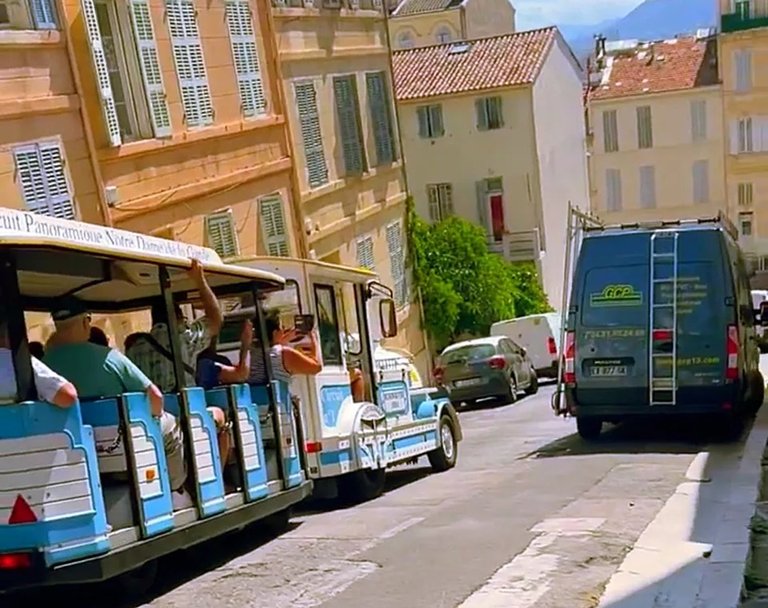
My husband and I got to Notre-Dame de la Garde, perhaps not the most rational, not the most economical, but the most acceptable way for our situation - on a tourist mini-train with a train departing from the Old Port embankment.
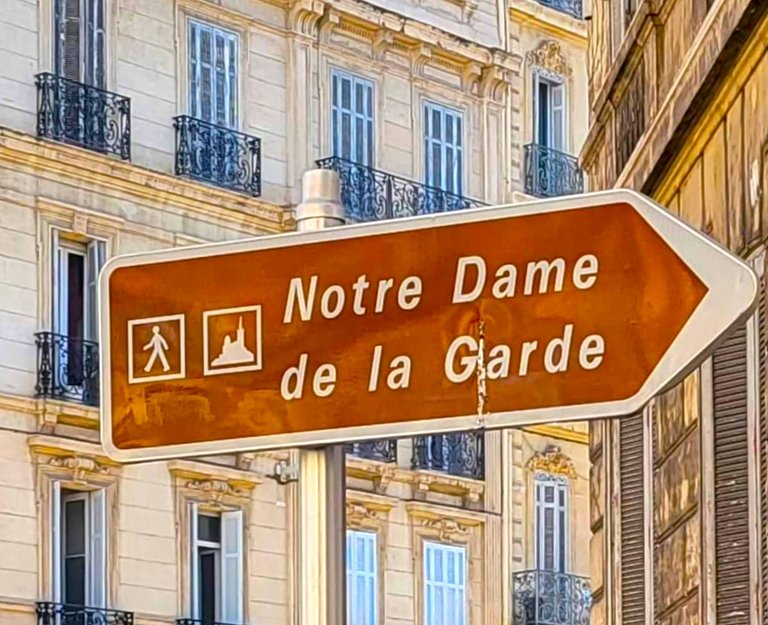
Some useful info about Notre-Dame de la Garde
A visit to the basilica is free for tourists and, what is especially pleasing, its dazzlingly bright interior decoration is allowed to be filmed on photo and video cameras.
When you approach the basilica, you are amazed at its height - you just lift your head and look! To enter the basilica, you need to climb the stairs and walk along the folding bridge, which, by the way, was installed not for the joy of tourists, but for protection and safety - every evening it rises, and thus, the basilica becomes an autonomous fortress! The restless centuries have passed, but the defensive function has remained!
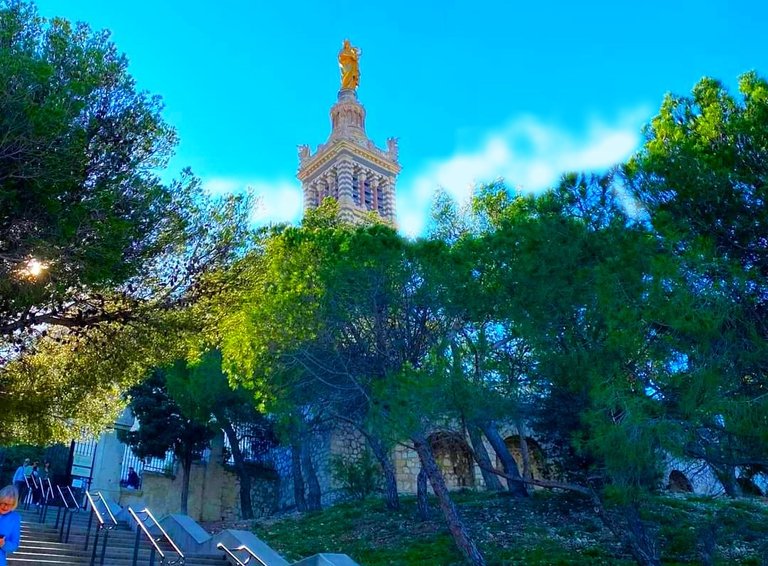
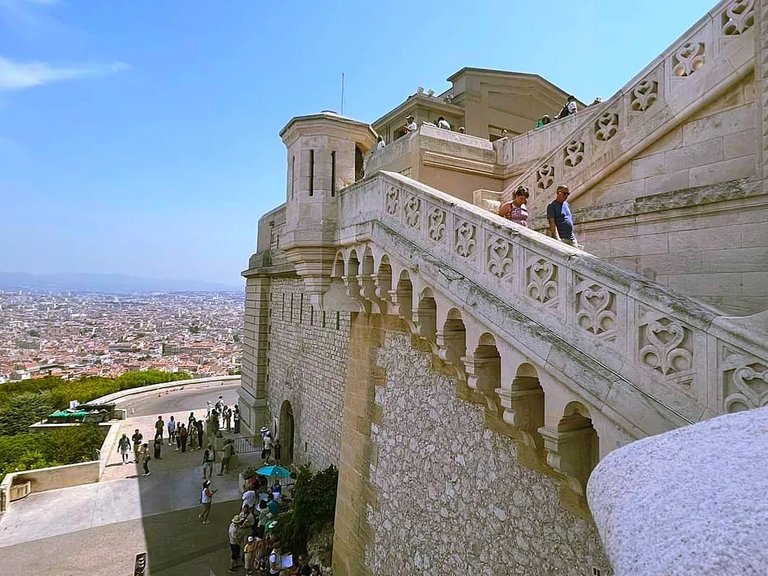

Like the Marseille Cathedral, Notre-Dame de la Garde was made of two-tone stone. However, in my opinion, in Notre-Dame de la Garde, the proportion of these colors looks more elegant. Especially when the sun's rays fall on it, and the basilica looks even more majestic! On such a small hill there is a 40-meter striped beauty!
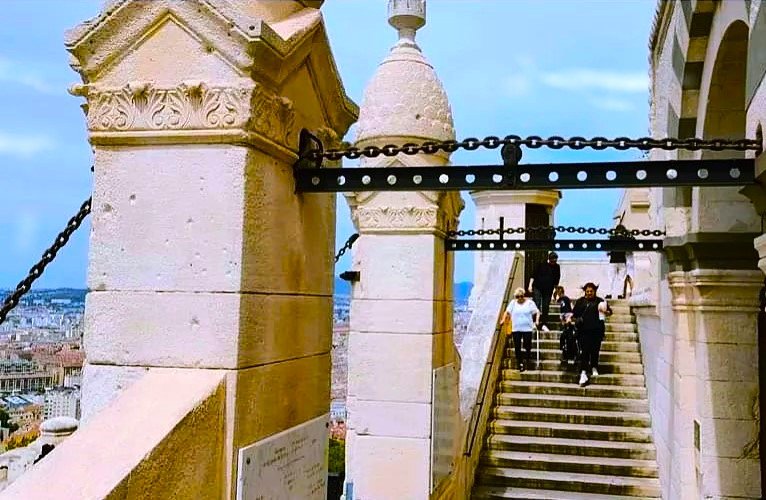

The Golden Queen of Marseille
While the people enjoy the observation platforms, admiring the patches of the Marseille quarters, the thin lines of the streets, the harbor, the sea and the Friuli archipelago from a 160-meter height, we raise our eyes to Madonna statue covered with gold leaf, who has been taking care of the crews of all Marseille ships for many years and vigilantly observing for the hectic city life. The Golden Queen of Marseille was created by Eugene Laquan.

The first impression of this huge figure is an enchanting pomposity, passing all the boundaries of the mind. However, having learned about the reasons for the construction of Notre-Dame de la Garde, you hardly want to be ironic about such excesses. And when you find out about the circumstances under which she survived during the Second World War - even more so. This church was built by practically all Marseilles - with the money of those who regularly went on long voyages, whose life was in constant struggle with the unpredictable sea elements and was in danger. For people who, due to the peculiarities of their profession, simply could not return home, which means they needed special support and patronage of the higher powers. Therefore, their desire to have a spacious, bright and heartily decorated church is quite understandable. And there is really nothing unique about choosing a place: on this hill back in the 13th century there was a chapel that performed the same functions: to pray for the health and well-being of sailors.

Decor of Notre-Dame de la Garde
When we entered Notre-Dame de la Garde, we almost drowned in an ocean of sparkling, flowery mosaics on a gold background that shimmered with all the colors of the rainbow. And it is clear that the authors of these multicolored works were inspired by Florence, Rome, Ravenna.
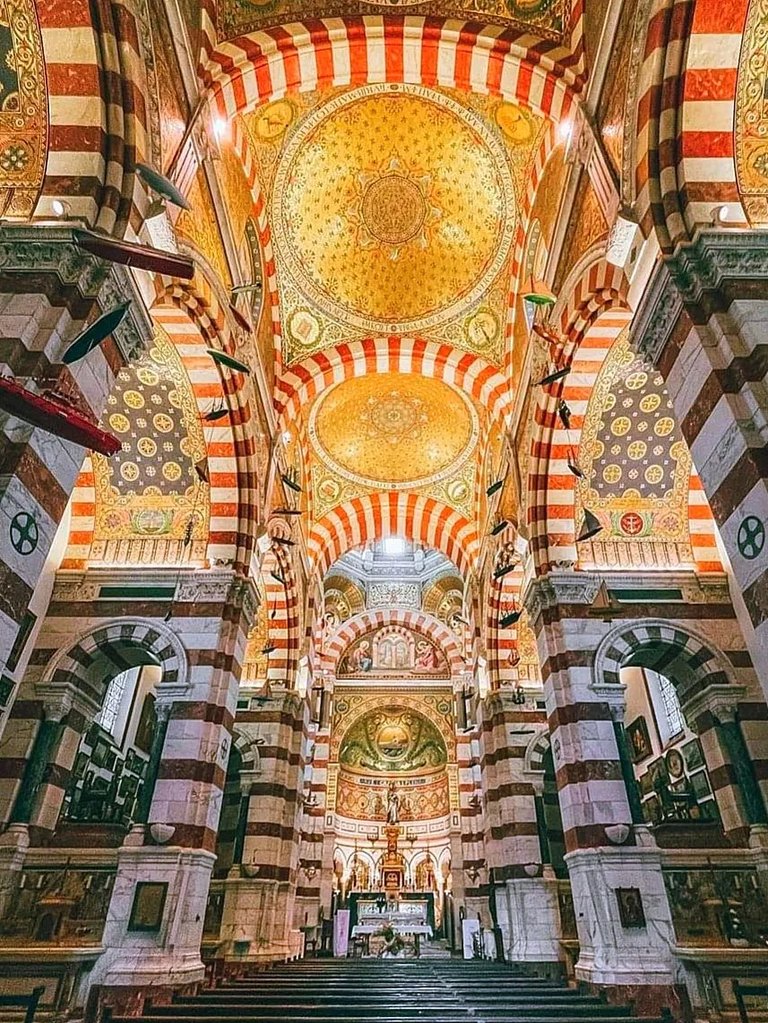
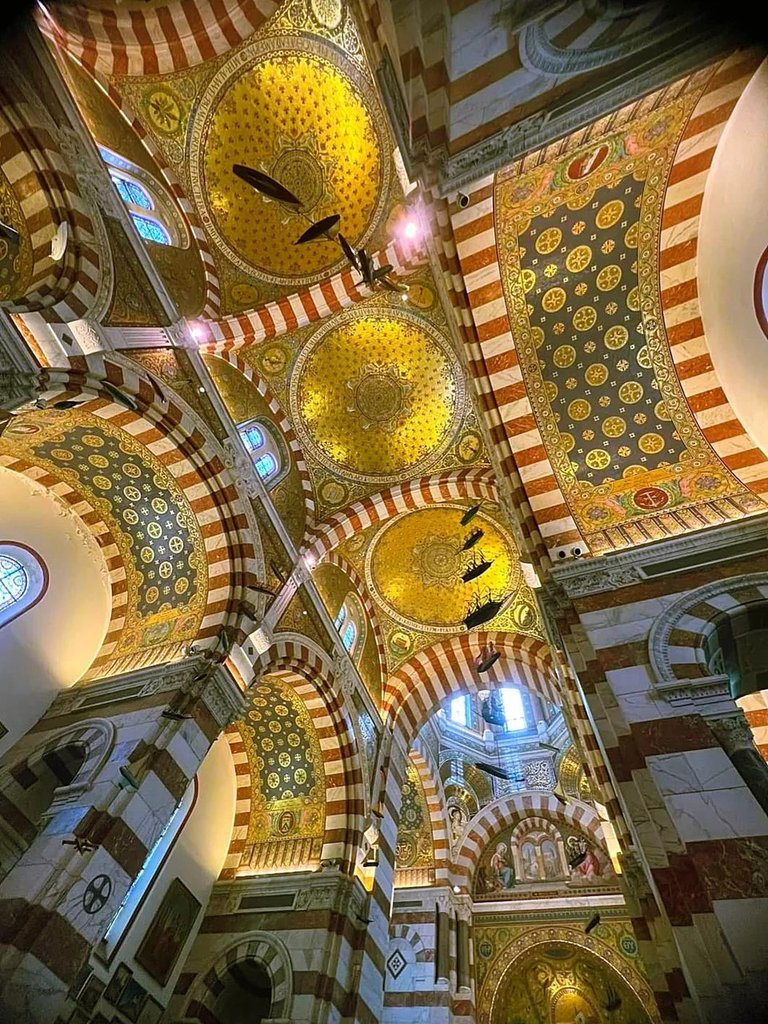
If on the bell tower, conceived as a pedestal, there is a golden Virgin Mary, inside, on the main altar, a silver Virgin Mary was installed. You truly pay tribute to the skill of its authors.
Behind the Virgin Mary, a magnificent mosaic with a ship is visible, symbolizing the Christian church, sailing on the stormy sea of life. Above the ship is a guiding star with the monogram of Mary, helping him successfully reach the port, in which there is a lighthouse with a cross at the top.
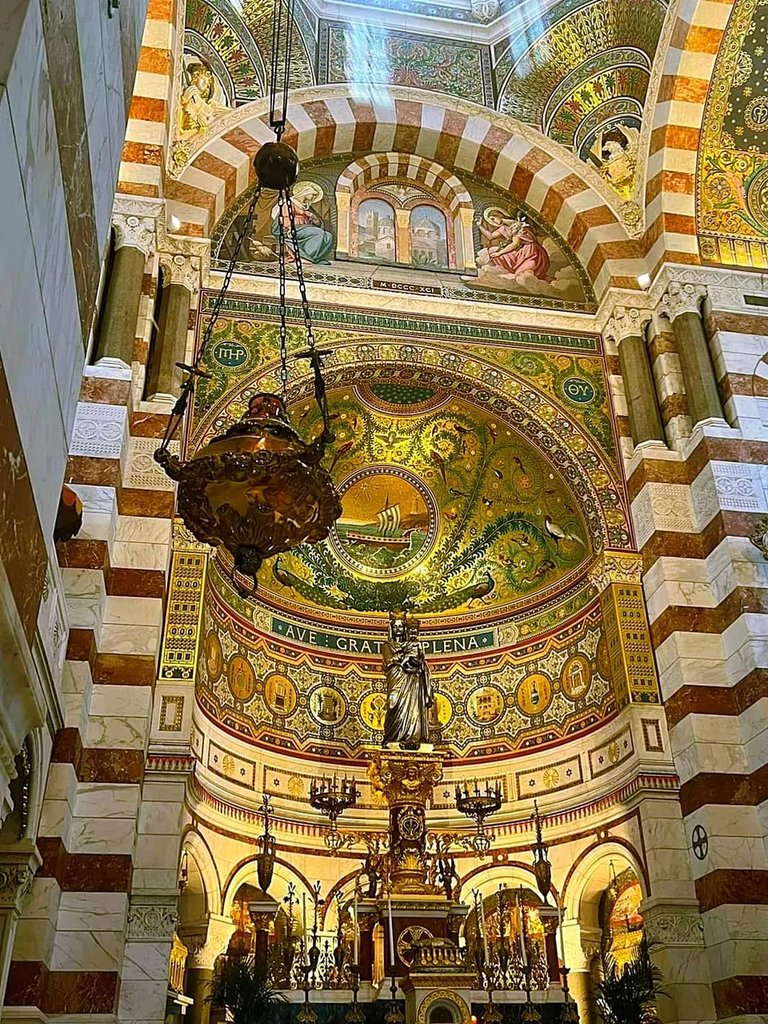
I was surprised not by the central plot of mosaic, but by a large number of birds. In addition to the predictable dove (as a symbol of the Holy Spirit), there were arrogant handsome peacocks, parrots, pheasants, herons and other species of birds that I have not identified. It turned out to be a wonderful bird kingdom. And I also admired the selection of shades of green in the vegetative part of the ornament.

In the basilica, there are a lot of decorative elements of a Catholic church - paintings, frescoes on the walls and ceiling, an abundance of baroque details. The interior repeats the striping of the exterior, with only a difference in colors and materials: if the exterior is white and green sandstone, which is abundant in the vicinity of Marseille, then the interior uses white and reddish marble - it alternates in stripes.
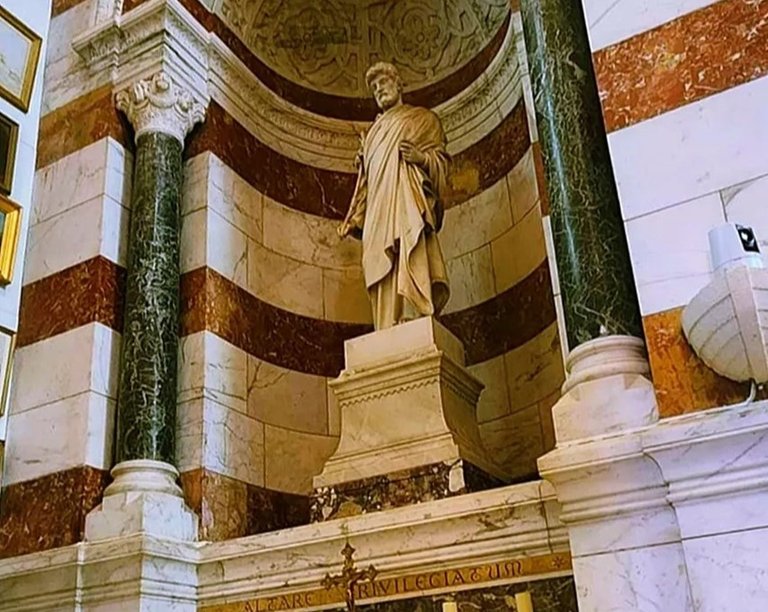

For whom this church is intended - it is clear without comment. Numerous models of ships hang from the ceiling, paintings with nautical scenes are on the walls.
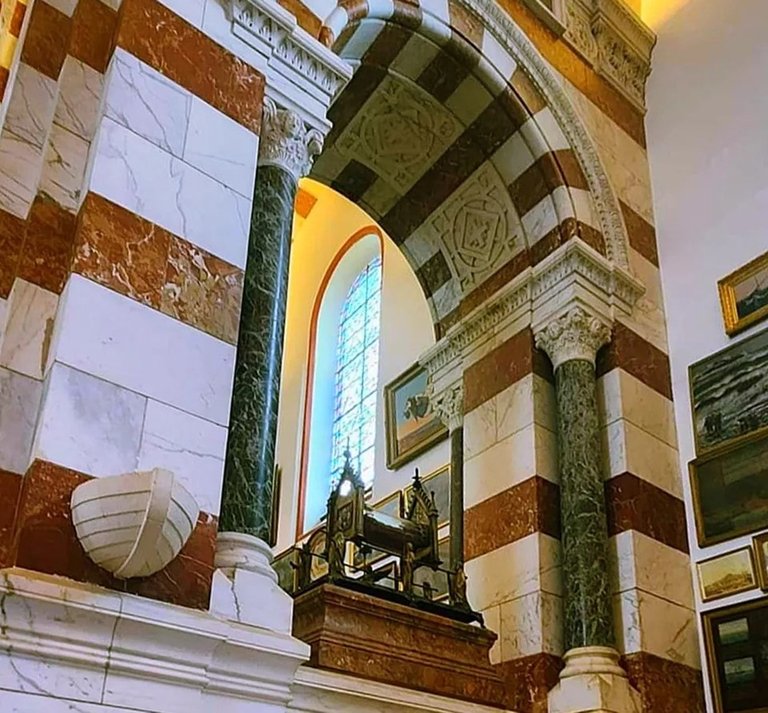
There are a lot of thank-you tables. Judging by the total number of gifts, the people of Marseilles call this temple the “Good Mother” for a reason.

The statue of the Virgin Mary, which we saw at the candle table in the crypt, seemed to me strikingly similar to the statue installed on the altar above (with the difference that the altar statue is wearing a crown). As it turned out, this is indeed a copy and it was specially made lighter than the original in order to be taken out of Notre Dame de la Garde once a year - during the traditional procession on the eve of the Assumption.

History of the Basilica
The basilica has gone through many bad moments over the years, but the worst was in 1944, when the retreating German troops planted explosives in the base, which did not work! Also, the Allied troops fired at the walls of this temple in order to knock out the enemy from there. The marks from the shelling of guns of various calibers on one of the facades still remain. The Marseilles do not want to close them up, as a memory and edification to posterity.
Thee object in the crypt is the charming Madonna with a bouquet. This statue is one of the most touching evidence of Marseille inhabitants' love for the temple. During the French Revolution, when a chapel still existed on the site of Notre-Dame de la Garde, church statues were seized and sent for melting down. After services resumed in the chapel, one of the parishioners bought this lovely wooden statue for her at auction at his own expense, and accordingly presented it as a gift.

The observation platforms at Notre-Dame de la Garde
The strategic position of the basilica is still visible to the naked eye - you can see the whole panorama of the city and the sea coast! It was not in vain that Charles 5 ordered a defensive fortress to be erected here along with a temple! Moreover, the builders of this basilica, which we all see, used fortifications from the Middle Ages, the walls of which are perfectly preserved.
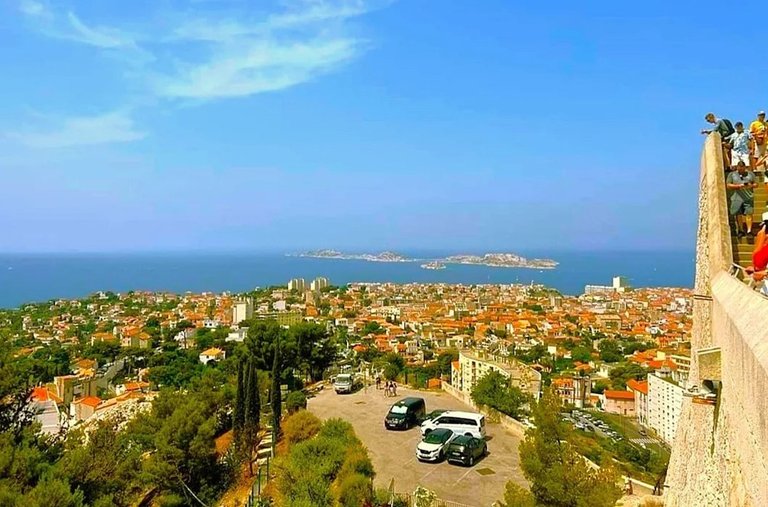

The undoubted star in the collection of views from here is the view of the iconic Chateau d'If, where Edmond Dantes, the future Count of Monte Cristo, languished in captivity, and other islands of the Friulian archipelago. I unconditionally give this view first place in the hit parade of Marseille landscapes.
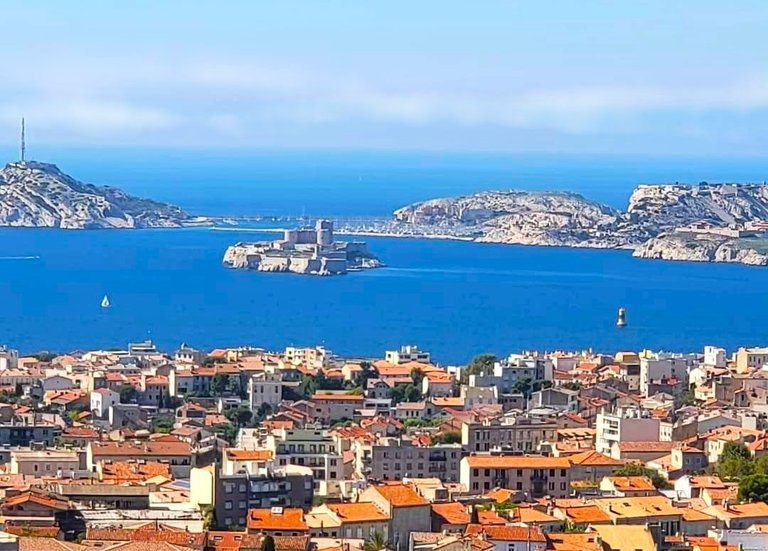
Another excellent view is the view of both Marseille ports: the old one - with a detachment of yachts, boats and pleasure boats, and the new one. On the left, a tandem of two forts: Saint-Jean and her counterpart - Saint-Nicolas.
In the foreground are residential houses built, most likely, in the last quarter of the 20th century. Of course, there are no masterpieces of architecture, but very many household touches visible to the eye give away their geography. Blinds, shutters or awnings on windows. Awnings on balconies. Flat roofs with gardens.
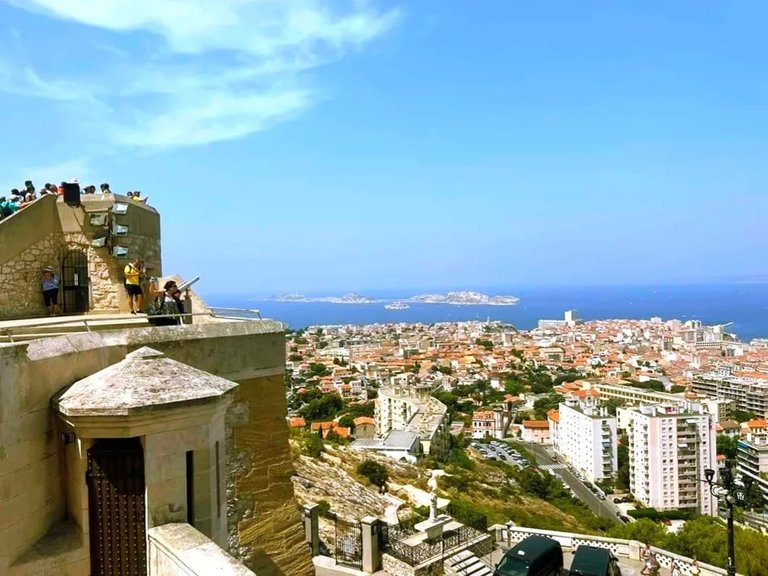
The observation platforms at Notre-Dame de la Garde are simply excellent. At different levels and in complete comfort: with surveillance cameras and explanatory signs.

If you get hungry, then at the basilica there is a restaurant run by women from the monastic order, even the waiters are from there! They cook only from products that are grown on the plot at the temple. You can even skip a glass of wine here at reasonable prices. But we didn't get there because we arrived very early. But according to other tourists, everything is delicious and inexpensive.
On the final note
I can’t say that I fell in love with Marseille with all my heart, but I am impressed by its natural, and not laboratory synthesized color and inexhaustible liveliness. And after climbing the hill from Notre-Dame de la Garde, this Provencal-Mediterranean terrible enfant is more tolerant.

Translated from Lithuanian via DeepL (free version)
💝💝💝💝💝💝💝💝💝💝
With love, @madeirane
Photos are taken by me.
© 2023.
Marselyje yra ypatinga vieta, kuri, mano nuomone, gali jei ne ištrinti, tai bent jau sušvelninti daugelį neigiamų įspūdžių apie šį miestą. Vis dėlto, jei vertinsime situaciją nešališkai, reiškiniai, dėl kurių turistai peikia Marselį, apskritai nėra egzotiški nei šiandieninei Prancūzijai, nei didiesiems Viduržemio jūros uostamiesčiams.
Taigi ypatinga vieta yra kalva, ant kurios stovi Marselio simbolis ir šventovė - Notre Dame de la Garde bazilika. Nuo jos varpinės didžiulė paauksuota Mergelės Marijos su Kūdikiu ant rankų statula žvelgia į miestą ir jūrą.
Su vyru į Notre Dame de la Garde nuvykome galbūt ne pačiu racionaliausiu, ne pačiu ekonomiškiausiu, bet mūsų situacijai priimtiniausiu būdu - turistiniu mini traukiniu, išvažiuojančiu iš Senojo uosto krantinės.
Apsilankymas bazilikoje turistams nemokamas, o ypač džiugina tai, kad jos akinamai ryškią interjero puošybą leidžiama filmuoti foto ir vaizdo kameromis.
Kai priartėjate prie bazilikos, nustebina jos aukštis - tereikia pakelti galvą ir pažvelgti! Norint patekti į baziliką, reikia užlipti laiptais ir eiti sulankstomu tilteliu, kuris, beje, įrengtas ne turistų džiaugsmui, o apsaugai ir saugumui - kiekvieną vakarą jis pakyla, ir taip bazilika tampa savarankiška tvirtove! Neramūs šimtmečiai prabėgo, bet gynybinė funkcija išliko!
Kaip ir Marselio katedra, Notre-Dame-de-la-Garde buvo pastatyta iš dviejų spalvų, t. y. balto ir žalio akmens. Tačiau, mano nuomone, Notre Dame de la Garde šių spalvų proporcijos atrodo elegantiškiau. Ypač kai ant jos krinta saulės spinduliai, ir bazilika atrodo dar didingiau! Ant tokios nedidelės kalvos stovi 40 metrų dryžuotas grožis!
Kol žmonės mėgaujasi apžvalgos aikštelėmis, iš 160 metrų aukščio grožėdamiesi Marselio kvartalų fragmentais, plonomis gatvių linijomis, uostu, jūra ir Friulio salynu, mes pakeliame akis į aukso lakštais padengtą Madonos statulą, kuri jau daugelį metų rūpinasi visų Marselio laivų įgulomis ir budriai stebi neramų miesto gyvenimą. Auksinę Marselio karalienę sukūrė Eugenijus Lakanas (Eugene Laquan).
Pirmasis įspūdis apie šią didžiulę figūrą - kerinti pompastika, peržengianti visas proto ribas. Tačiau sužinojus apie Notre Dame de la Garde pastatymo priežastis, vargu ar norisi ironizuoti tokį ekscesą. O kai sužinai, kokiomis aplinkybėmis ji išliko per Antrąjį pasaulinį karą - dar labiau. Šią bažnyčią statė praktiškai visas Marselis - už pinigus tų, kurie nuolat leisdavosi į ilgas keliones, kurių gyvybė nuolat kovojo su nenuspėjamomis jūros stichijomis ir buvo pavojuje. Žmonėms, kurie dėl savo profesijos ypatumų tiesiog negalėjo grįžti namo, vadinasi, jiems reikėjo ypatingos aukštesnių jėgų paramos ir globos. Todėl jų noras turėti erdvią, šviesią ir širdžiai mielą bažnyčią yra visiškai suprantamas. Ir tikrai nėra nieko išskirtinio, kad būtų pasirinkta unikali vieta: ant šios kalvos dar XIII a. stovėjo koplyčia, kuri atliko tas pačias funkcijas: meldėsi už jūreivių sveikatą ir gerovę.
Įžengę į Notre-Dame-de-la-Garde beveik paskęstame vandenyne blizgančių gėlėtų mozaikų auksiniame fone, kuris mirgėjo visomis vaivorykštės spalvomis. Ir akivaizdu, kad šių įvairiaspalvių kilimų autorius įkvėpė Florencija, Roma, Ravena.
Jei ant varpinės bokšto, sumanyto kaip postamentas, yra auksinė Mergelė Marija, tai viduje, pagrindiniame altoriuje, buvo įrengta sidabrinė Mergelė Marija. Jūs iš tiesų atiduodate duoklę jos autorių meistriškumui.
Už Mergelės Marijos matyti puiki mozaika su laivu, simbolizuojančiu krikščionių bažnyčią, plaukiančią audringoje gyvenimo jūroje. Virš laivo yra kelrodė žvaigždė su Marijos monograma, padedanti jam sėkmingai pasiekti uostą, kurio viršuje yra švyturys su kryžiumi.
Tačiau šioje mozaikoje mane nustebino ne centrinis siužetas, o daugybė paukščių. Be nuspėjamo balandžio (kaip Šventosios Dvasios simbolio), buvo arogantiškų gražuolių povų, papūgų, fazanų, garnių ir kitų paukščių rūšių, kurių neidentifikavau. Pasirodė, kad tai buvo nuostabi paukščių karalystė. Taip pat žavėjausi parinktais žalios spalvos atspalviais augalinėje ornamento dalyje.
Bazilikoje gausu katalikų bažnyčios puošybos elementų - paveikslų, freskų ant sienų ir lubų, gausu barokinių detalių. Interjere pasikartoja eksterjero dryžiai, skiriasi tik spalvos ir medžiagos: jei eksterjere naudojamas baltas ir žalias smiltainis, kurio gausu Marselio apylinkėse, tai interjere naudojamas baltas ir rausvas marmuras - jis kaitaliojasi juostomis.
Kam skirta ši bažnyčia - aišku ir be komentarų. Nuo lubų kabo daugybė laivų modelių, ant sienų kabo paveikslai su jūriniais siužetais.
Yra daug padėkos stalų. Sprendžiant iš bendro dovanų skaičiaus, Marselio gyventojai ne veltui šią šventyklą vadina "Gerąja motina".
Mergelės Marijos statula, kurią matėme prie žvakių stalo kriptoje, man pasirodė labai panaši į aukščiau esančiame altoriuje įrengtą statulą (skirtumas tik tas, kad altoriaus statula turi karūną). Kaip paaiškėjo, tai iš tiesų yra kopija ir ji buvo specialiai pagaminta lengvesnė už originalą, kad kartą per metus - per tradicinę procesiją Marijos Ėmimo į dangų išvakarėse - būtų išnešama iš Notre Dame de la Garde.
Per daugelį metų bazilika patyrė daug blogų akimirkų, tačiau pati blogiausia buvo 1944 m., kai besitraukiantys vokiečių kariai bazilikoje padėjo sprogmenų, kurie nesuveikė! Be to, sąjungininkų kariai šaudė į šios šventyklos sienas, kad iš ten nukautų priešą. Ant vieno iš fasadų vis dar išlikę įvairaus kalibro ginklų apšaudymo žymės. Marselis nenori jų uždaryti, kaip atminimo ir pamokinimo palikuonims.
Strateginė bazilikos padėtis vis dar matoma plika akimi - nuo jos atsiveria visa miesto ir jūros pakrantės panorama! Ne veltui Karolis 5 įsakė čia pastatyti gynybinę tvirtovę ir šventyklą! Be to, šios bazilikos, kurią visi matome, statytojai naudojo viduramžių įtvirtinimus, kurių sienos puikiai išsilaikiusios.
Tačiau iš tikrųjų kriptoje esantis objektas, kurį būtina pamatyti, žinoma, yra žavinga Madona su puokšte. Ši statula yra vienas iš labiausiai jaudinančių Marselio gyventojų meilės savo šventovei įrodymų. Per Prancūzijos revoliuciją, kai Notre-Dame-de-la-Garde vietoje dar stovėjo koplyčia, bažnytinės statulos buvo konfiskuojamos ir siunčiamos išlydyti. Atnaujinus pamaldas koplyčioje, vienas iš parapijiečių savo lėšomis aukcione nupirko jai šią gražią medinę statulą ir atitinkamai padovanojo.
Kaip jau minėjau, viena iš priežasčių, kodėl Notre-Dame-de-la-Garde turi nuolatinį pasisekimą turistų tarpe, yra Marselio panorama. Neapsakomai įspūdingas dangaus ir Viduržemio jūros žydrumo derinys, balti burių kableliai, čerpių stogai, apsupti žalumos - niekas negali likti abejingas tokiems vaizdams.
Neabejotina žvaigždė iš čia atsiveriančių vaizdų kolekcijoje yra vaizdas į kultinį Chateau d'If, kur nelaisvėje glaudėsi būsimasis Monte Kristo grafas Edmondas Dantesas, ir kitas Friulio salyno salas. Šiam vaizdui besąlygiškai skiriu pirmąją vietą Marselio kraštovaizdžių hitparade.
Kitas puikus vaizdas - tai abiejų Marselio uostų vaizdas: senojo - su jachtų, katerių ir pramoginių laivų būriu, ir naujojo. Kairėje - dviejų fortų tandemas: Saint-Jean ir jo antrininkas - Saint-Nicolas.
Pirmame plane - gyvenamieji namai, pastatyti greičiausiai XX a. paskutiniame ketvirtyje. Žinoma, čia nėra architektūros šedevrų, tačiau labai daug akiai matomų buitinių akcentų išduoda jų geografiją. Žaliuzės, langinės ar markizės ant langų. Markizės ant balkonų. Plokšti stogai su sodais.
Notre Dame de la Garde apžvalgos aikštelės yra tiesiog puikios. Įvairių lygių ir visiškai patogios: su stebėjimo kameromis ir aiškinamaisiais ženklais.
Jei išalksite, bazilikoje yra restoranas, kuriam vadovauja vienuolių ordino moterys, net padavėjai yra iš ten! Jos gamina maistą tik iš šventyklos sklype užaugintų produktų. Čia galite net praleisti vyno taurę už priimtiną kainą. Tačiau mes ten nepatekome, nes atvykome labai anksti. Tačiau, pasak kitų turistų, viskas skanu ir nebrangu.
Negaliu sakyti, kad įsimylėjau Marselį visa širdimi, bet mane sužavėjo jo natūralus, o ne dirbtinai susintetintas koloritas ir neišsenkantis gyvybingumas. O užkopęs į kalną nuo Notre Dame de la Garde, šis Provanso ir Viduržemio jūros regiono baisusis enfantas tapo tolerantiškesnis.
💝💝💝💝💝💝💝💝💝💝
Su meile, @madeirane
Nuotraukos darytos mano.
© 2023.

Congratulations, your post has been added to Pinmapple! 🎉🥳🍍
Did you know you have your own profile map?
And every post has their own map too!
Want to have your post on the map too?
Congratulations @madeirane! You have completed the following achievement on the Hive blockchain And have been rewarded with New badge(s)
Your next target is to reach 9000 upvotes.
You can view your badges on your board and compare yourself to others in the Ranking
If you no longer want to receive notifications, reply to this comment with the word
STOP